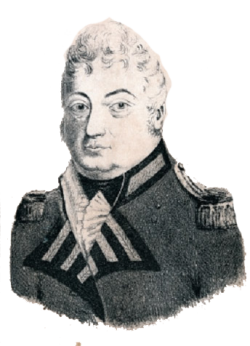Early career
Don was born in 1756, the second son of wine merchant John Don and his wife Anna Seton. In 1770 he joined the army as an ensign in the 51st Regiment of Foot and was stationed in Minorca from 1774 after being made lieutenant. Minorca was at the time a British-administered territory and naval base and was heavily fortified after its capture by the Spanish and recapture in the Seven Years War twenty years earlier. During his service on the island, Don became close acquaintances with the island's governor General Johnstone and General James Murray and served on the staff of the former as aide-de-camp and was consequently promoted to captain. During the American Revolutionary War, Minorca came under attack by Spanish and French forces and Don was an important figure in the seven month siege of the British garrison in Fort St. Philip. Despite the enforced surrender of the garrison in 1782, Don's reputation was enhanced and he gained further status when he married Murray's niece Maria Margaretta in 1783. Promoted major the same year, he transferred to the 59th Regiment of Foot for his first posting in Gibraltar, where he served on peacetime duty until 1791. With war again looming in the aftermath of the French Revolution, Don was promoted to lieutenant colonel and given a staff appointment in Jersey, where his regiment was stationed in 1792. Jersey was an obvious target of the French if war was declared, and Don worked on the island's defences before being called away by Murray in 1793 to serve as his aide-de-camp in the unsuccessful Flanders Campaign. For his services in this campaign, Don was given the ceremonial post of Aide-de-Camp to King George III and was promoted to full colonel
French Revolutionary War
Don was not evacuated with the rest of the British army in 1795 after the campaign's collapse, but instead was seconded to the Prussian court as a liaison officer and may have coordinated espionage activities against France during this period, although records are vague. In 1798 he returned to Britain as a major-general and was placed in command of the defences of the Isle of Wight, a weak spot on the Southern Coast of England. In 1799, he was attached to the force under the Duke of York which invaded the Batavian Republic with an Anglo-Russian army. He was frequently detached on espionage and negotiation duties, culminating in his arrest by Guillaume Brune during negotiations to allow a peaceful withdrawal of allied troops. Don spent the next two years in prison, only being released at the end of 1800 in the prelude to the Peace of Amiens.
Governorships
In 1805 Don's colonelcy was transferred to the 96th Regiment of Foot and in 1806 he was made Lieutenant-Governor of Jersey, a post he maintained for the entire Napoleonic Wars. He built roads and defences, organised local militia and built up a strong relationship with the local community. In 1814 after lengthy service in Jersey, Don became a full general and took the post of Lieutenant-Governor of Gibraltar.
When Don arrived in Jersey in 1806 the only roads the Island could boast of were numerous narrow communications winding in and out in an aimless manner, in general "sunken below the level of the land, and flanked on each side by high mounds" in the same fashion as is presented even now by the majority of the by-lanes.
These apologies for roads were divided in all into three classes : Le chemin du roi, with foot walks 16 feet wide between the hedge banks; Le chemin de huits pieds, or cross-roads, 8 feet wide, and Le chemin de quatre pieds, or extremely narrow bridle-ways, to which may be added sheep tracts, which at that time abounded to a considerable extent—all often impassable in bad weather, and allowing as a rule only the passage of one vehicle at a time.
To the soldierly eye of General Don such a state of affairs was no longer satisfactory, and during the first year of his appointment he had work started on many of the main roads which still exist to this day, primarily for the convenience of the marching of his troops.
Fort Regent
He also had work completed on coastal towers and the foundation stone of Fort Regent was laid by him on 7 November 1806. In doing all this, General Don faithfully carried forward and brought to a climax the schemes of his predecessor, General Conway.
He also took interest in the general welfare of the Island and frequently sat with Sir John Dumaresq, Lieut.-Bailiff, in the Royal Court, where, being a fluent French scholar, he had every opportunity of becoming more conversant with the laws and institutions of the Island.
Other important events during his time in the island included the building of a chapel in Don Street for the combined use of the French and English Wesleyans in 1807; and the abolition of the customary public rejoicing on the anniversary of the Restoration of Charles II, the last fete in connection with which was celebrated, with Don for its leader, on 29 May 1807.
Other articles






